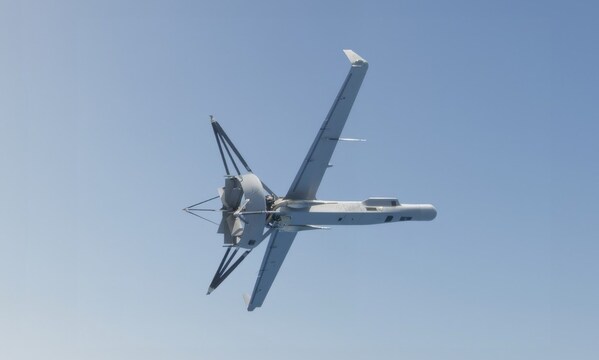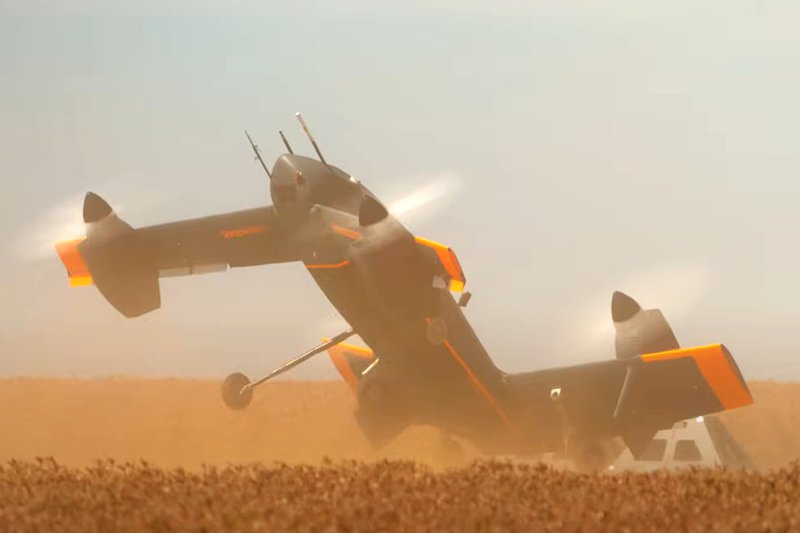
REPORT HOME > News
APRIL 2025 | technology report | UAS
by LUCY POWELL
The heavy-fuel engine V-Bat was officially showcased at Sea Air Space, after it was first teased in February 2025.
Above: The latest evolution of the V-Bat is built to solve issues with targeting threats in GPS-denied environments and enabling maritime surveillance. (Photo: Shield AI)
Shield AI has officially unveiled its new upgrade variant of the V-Bat, at the Sea Air and Space exhibition on 7 April.
This upgraded V-Bat has a heavier fuel engine, optimised for JP-5 – the common maritime aircraft fuel – extending the uncrewed aerial vehicle’s endurance over 13 hours according to the company.
It also now has a fully unassisted vertical launch and landing (VTOL) capability, and like previous V-Bat variants, requires no catapult or runway. The variant has a higher MTOW of 73kg and payload capacity of 18.1kg, compared to 57kg and 11.3kg, respectively, of previous versions.
As with earlier variants, the new V-Bat model is both Hivemind pilot-ready and has SATCOM integration, Shield AI confirmed. It also supports multi-payload integration.
Brandon Tseng, Shield AI's president, co-founder, and a former Navy SEAL said: “V-Bat is built for the full spectrum of drone missions—from deep-penetration ISR-T where GPS and comms are jammed to border security, search and rescue, and drug interdiction. If there's a mission out there, V-Bat can do it—faster, cheaper, and where others can't.”
The model was first teased at IDEX 2025 in February, its first public showcase. Shield AI also told Shephard in March that this latest product was already in production and contracted by customers.
On 1 April 2025, the new variant also successfully showcased its resilience to electronic warfare during Project Convergence Capstone 5 (PC-C5). The V-Bat was deployed on long-range air assaults and demonstrated its ability to operate in contested conditions to provide ISR support, Shield AI said.
The US Coast Guard selected the V-Bat in a deal worth US$198 million in July 2024. The Japanese Maritime Self-Defence Force also selected the V-Bat for UAS ISR missions in January 2025 for an undisclosed number of UAVs, with the first deliveries expected later this year.
Next article below > Avalon 2025: BAE Systems eyes customers for its Strix after initial flight
April 2025 | technology report | uas
by roy choo
The Strix test effort suffered a setback last year when the prototype incurred minor damage in a hard landing during its second trial flight.
Above: Instead of the kink in the forewings as seen in this mock-up, the final design of the Strix will feature straight wings instead. (Photo: author)
BAE Systems Australia is seeking potential customers for its Strix vertical take-off and landing (VTOL) uncrewed aerial system (UAS) to take it to the next stage of development following first flight last year.
The company also disclosed to Shephard at the Avalon Australian International Airshow near Melbourne last week that it is in talks with a number of parties who have expressed interest in the UAS.
The platform was unveiled at the previous air show in 2023 and a BAE Australia spokesperson said the company decided to embark on the development of a prototype following interest at the event.
It was developed in collaboration with Perth-based aeronautics company Innovaero, which provided its expertise in designing and rapidly prototyping aeronautical products and an all-electric prototype was produced. This was intended to be an aerodynamically representative model that could be fabricated within a shorter time frame for testing and without the combat systems for its intended roles.
The BAE Systems Australia spokesperson also added the Strix utilised its autonomous platform technology, such as the vehicle management system, versions of which are used in the MQ-28 Ghost Bat, M113 AS4 optionally crewed combat vehicles and Nulka active missile decoys.
The initial test flight took place in a remote location in Western Australia last October 2024 and while the hover function was successfully tested, the prototype did not transition to horizontal flight.
The programme faced a minor setback during the second flight late that month, when it encountered a heavy landing, resulting in superficial damage to a wing and the propellers. Investigations revealed a fault in the electric speed control of one of the engines during launch and BAE Systems Australia said that the damage is being repaired.
Refinements have been made to the design of the Strix and these have been incorporated into the prototype.
The latest prototype features a straight win design instead of the kink in the forewings, intended to allow better ground clearance, as featured in the mock-ups at both Avalon airshows. This change improves lift generation.
The propellers also have three blades instead of two in the mock-ups, allowing more thrust and engine efficiency.
Above: TThe Strix prototype conducted its initial test flight in October 2024. (Photo: BAE Systems Australia)
BAE Systems Australia also shared that the project is still internally funded at this stage and hopes to partner with customers to take it to the next stage with some customers enquiring about specific roles.
While not a programme of record, it is understood the Australian Defence Force has sought information about a Loyal Wingman UAS for its soon to be delivered Apache AH-64E attack helicopters as part of manned-unmanned teaming operations.
The US Marine Corps has also enquired about an intelligence, surveillance and reconnaissance and strike–capable UAS for operations in the littoral environment.


